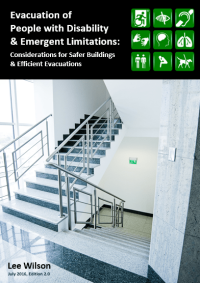‘Evacuation of People with Disability & Emergent Limitations: Considerations for Safer Buildings & Efficient Evacuations’, 2nd Edition was released by Lee Wilson in July 2016.
 Lee Wilson researched the area of evacuation considerations for people with disability for over 12 months. Following this, the first edition of the Guide was produced titled “Evacuation of People with Disability & Emergent Limitations: Considerations for Safer Buildings & Efficient Evacuations”.
Lee Wilson researched the area of evacuation considerations for people with disability for over 12 months. Following this, the first edition of the Guide was produced titled “Evacuation of People with Disability & Emergent Limitations: Considerations for Safer Buildings & Efficient Evacuations”.
Two years later the 2nd edition was released with new content and discussion on the needs of people with disability, including new terrorist threats.
The2nd edition of the Guide contains 189 pages in total, including useful information with considerations for all building occupants, including people with disability. The Guide includes templates for personal and group emergency evacuation plans (PEEPs and GEEPS). Whilst undertaking the research to prepare the Guide it became evident that:
- Building owners, building managers, and employers need to take a holistic and pro-active approach in ensuring they have met the needs of all building occupants and have plans in place for evacuation of their building; and
- A significant proportion of people entering these buildings could be exposing themselves to an unacceptable risk every time they enter – unless their needs have been considered and the necessary plans for their safe evacuation are in place.
The primary objectives of the Guide are to:
- Help workplaces and employees work collaboratively to develop personal emergency evacuation plans.
- Provide guidance to employers and facility managers, so that they may identify opportunities to reduce risk and provide a safer built environment.
- Assist building occupants, including people with disability to identify strategies to:
-
- Reduce their own risk exposure
- Understand legislative requirements
- Determine who is responsible for their personal safety and evacuation planning
- Equip them with the knowledge and resources to ask the right questions about their own safety
- Work with their employers to develop an individual personal emergency evacuation plan
-

